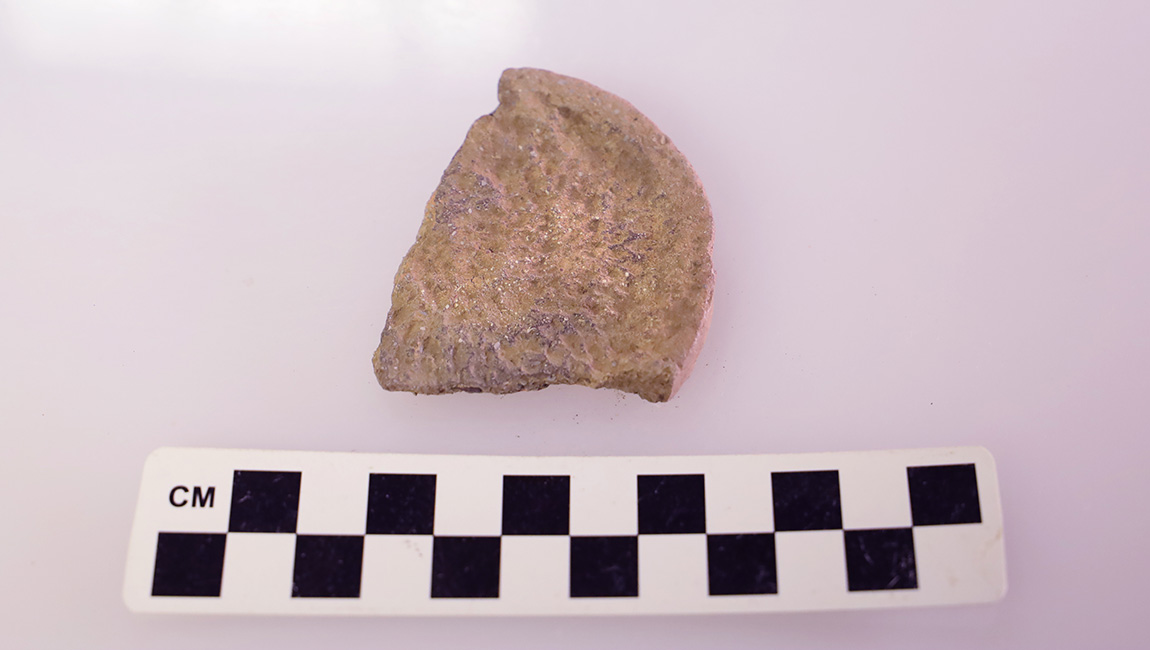Emily L. Beahm, Arkansas Archeological Survey, Winthrop Rockefeller Institute Station
Artifact of the Month – March 2021
This month’s artifact is a ceramic sherd. It is a piece from the base of a round, flat-bottomed ceramic vessel. The vessel was made out of clay with crushed mussel shell added as temper to prevent cracking while firing and to increase the vessel’s strength after firing. The sherd measures 52 mm (2 inches) wide, 63 mm (2.5 inches) long, and 6.7 mm (0.26 inches) thick and weighs 22 grams (0.78 ounces). What makes this sherd especially interesting is that it has an impression on the outside surface of a mat or basket it was sitting on while the vessel was being formed and the clay was still wet and malleable.

This sherd was found at the Heber Springs site (3CE68). At one time the Heber Springs site included a low, oval mound. In 1979, Arkansas Archeological Survey archeologist Robert Ray conducted some salvage work there after he was contacted by the site’s owner. The landowner informed Ray that there was a good possibility the mound would be destroyed, as he had plans to sell the soybean field where the site and mound were located for development. In addition to mapping the site, Ray and other Survey archeologists excavated a 30-meter-long trench and four small test units into the mound to study the techniques and timing of mound construction. This basket-impressed base sherd was excavated from a unit near the southern end of the mound at a depth of 28 to 38 cm below ground surface (or 130–140 cm below datum) in unit N12 E48 E1/2. A small Scallorn arrow point was also excavated from this level.
Basketry impressions on flat-bottomed vessels have been recorded elsewhere, mainly from mid-to-late Woodland period sites (Dellinger and Dickenson 1942; Horton 2010:405; Sabo et al. 1990:75). In Arkansas they have been found at the Wild Violet site (3LO226), 3LO183, the Poole site (3GA3), and the Crooked Creek site (3FR26), although these examples are on clay-tempered, rather than shell-tempered, sherds (Hoffman et al. 1977:53; Wood 1981:33). Shell-tempered flat-bottomed ceramics with basketry impressions on the base were reported from the Ira Spradley site (3NW101) and 3CE12 to mention just a few (McGimsey 1959:19; Sabo and Hilliard 2008). One such vessel from Ira Spradley yielded an AMS date of cal. A.D. 652–882 at 2 sigma [CALIB 7.0.4 on 1280 ± 60 B.P. (Beta-123306; d13C= -21.3%)] (Sabo and Hilliard 2008). AMS dates are currently being processed, but similar dates are anticipated for use of the Heber Springs site.

Organic material such as grasses and wood need special environmental conditions to be preserved. In the Ozarks, bluff shelters have provided a consistently dry environment and allowed for the preservation of seeds, wooden objects, bags, sandals, mats, and baskets (see Artifact of the Month for October 2019, January 2018, and June 2018). Detailed studies of the perishable material from the Ozark bluff shelters at the University of Arkansas have yielded some incredible insights (Fritz 1986; Horton 2010; Scholtz 1975). Unfortunately, that type of preservation in artifacts made out of plants is very rare in the southeastern and midwestern United States, and unless the objects are carbonized (charred), they will not be represented in the archeological record. Sometimes, if we are lucky, we can learn about the types of fabric and basketry made by Native People by looking at impressions left on ceramic surfaces. In the case of this month’s artifact, we can observe that the people living at the Heber Springs site were making and using coiled baskets. Based on observed use-wear and their overall form, coiled baskets were likely made for food preparation activities like parching and cooking (Horton 2010:408). A more comprehensive study of ceramic sherds with basketry impressions and comparison to preserved basketry from bluff shelter sites in the future will lead to greater understanding of the technology, foodways, and relationships among Native People of Arkansas.
Materials: clay and mussel shell
Dimensions: 52mm x 63mm x 6.7mm
Age Estimate: A.D. 600–1000
Accession #79-501-3
N12 E48 E1/2, Level 3
Courtesy of Arkansas Archeological Survey
References
Dellinger, Samuel, and S. D. Dickenson
1942 Pottery from the Ozark Bluff Shelters. American Antiquity 7(3):276–289.
Fritz, Gayle J.
1986 Prehistoric Ozark Agriculture: The University of Arkansas Rockshelter Collections. Unpublished Ph.D. dissertation. The University of North Carolina, Chapel Hill.
Hoffman, Michael P., Nancy E. Myer, Dan Printup, and Clell L. Bond
1977 Ozark Reservoir Papers: Archeology in West-Central Arkansas 1965–1970. Research Series No. 10. Arkansas Archeological Survey, Fayetteville.
Horton, Elizabeth T.
2010 The Ties That Bind: Fabric Traditions and Fiber Use in the Ozark Plateau. Unpublished Ph.D. dissertation. Washington University, St. Louis.
McGimsey, Charles
1959 An Archeological Survey of the Greers Ferry Reservoir in North-Central Arkansas. Report prepared for the National Park Service, University of Arkansas, Fayetteville.
Sabo, George III, Ann M. Early, Jerome C. Rose, Barbara A. Burnett, Louis Vogel Jr., and James P. Harcourt
1990 Human Adaptation in the Ozark and Ouachita Mountains. Research Series No. 31. Arkansas Archeological Survey, Fayetteville.
Sabo, George III. and Jerry E. Hilliard
2008 Woodland Period Shell-Tempered Pottery in Central Arkansas Ozarks. Southeastern Archaeology 27(2):164–171.
Scholtz, Sandra Clements
1975 Prehistoric Plies: A Structural and Comparative Analysis of Cordage, Netting, Basketry and Fabric from Ozark Bluff Shelters. Research Series No. 9. Arkansas Archeological Survey, Fayetteville
Wood, W. Raymond
1981 The Poole Site. The Arkansas Archeologist 22:7–62.
 Collections and items in our institution have incomplete, inaccurate, and/or missing attribution. We are using this notice to clearly identify this material so that it can be updated, or corrected by communities of origin. Our institution is committed to collaboration and partnerships to address this problem of incorrect or missing attribution. For more information, visit localcontexts.org.
Collections and items in our institution have incomplete, inaccurate, and/or missing attribution. We are using this notice to clearly identify this material so that it can be updated, or corrected by communities of origin. Our institution is committed to collaboration and partnerships to address this problem of incorrect or missing attribution. For more information, visit localcontexts.org.
 The Arkansas Archeological Survey is committed to the development of new modes of collaboration, engagement, and partnership with Indigenous peoples for the care and stewardship of past and future heritage collections.
The Arkansas Archeological Survey is committed to the development of new modes of collaboration, engagement, and partnership with Indigenous peoples for the care and stewardship of past and future heritage collections.
 The TK Notice is a visible notification that there are accompanying cultural rights and responsibilities that need further attention for any future sharing and use of this material. The TK Notice may indicate that TK Labels are in development and their implementation is being negotiated. For more information about the TK Notice, visit localcontexts.org.
The TK Notice is a visible notification that there are accompanying cultural rights and responsibilities that need further attention for any future sharing and use of this material. The TK Notice may indicate that TK Labels are in development and their implementation is being negotiated. For more information about the TK Notice, visit localcontexts.org.
